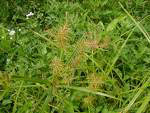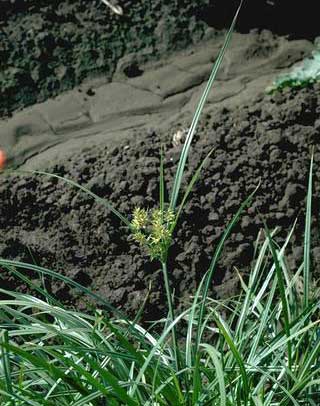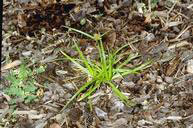
Nutsedges are common weeds in landscapes and gardens. They thrive in waterlogged soil and their presence often indicates that drainage is poor, irrigation is too frequent, or sprinklers are leaky. Once established, however, they will tolerate normal irrigation conditions or drought. The two most common species of nutsedge are yellow nutsedge (Cyperus esculentus) and purple nutsedge (C. rotundus).
IDENTIFICATION
Although nutsedges are often referred to as "nutgrass" and resemble grasses, they are not grasses but true sedges. Their leaves are thicker and stiffer than most grasses and are arranged in sets of three at the base, whereas grass leaves are opposite in sets of two. Nutsedge stems are solid, and when looked at in cross section, they are triangular; grass stems are hollow and round, and in cross section they are almost flat or oval. Nutsedge has three long, leaflike bracts at the base of each flower head. Yellow nutsedge has light brown flowers and seed, and purple nutsedge flowers have a reddish tinge and the seed are dark brown or black.

Yellow and purple nutsedges produce tubers, which are incorrectly called "nuts" or "nutlets," thus the origin of its common name. These tubers are produced on rhizomes (underground stems) that grow as deep as 8 to 14 inches below the soil surface. Buds on the tubers sprout and grow to form new plants; thus individual nutsedge plants eventually form patches that can range up to 10 feet or more in diameter. Yellow nutsedge produces round, smooth, brown or black tubers that are about 1/2 inch at maturity. Only one tuber is formed at the end of a rhizome. Tubers of a yellow nutsedge plant have a pleasant almond taste. Tubers of purple nutsedge plants are covered with red or red-brown scales and are formed in chains with several tubers on a single rhizome. These tubers are bitter to the taste.
Be careful not to confuse yellow or purple nutsedge with tall umbrella sedge (C. eragrostis), another perennial sedge that is found in wet, soggy soils. Tall umbrella sedge is a large, light green sedge that does not produce tubers. It spreads by seed or by new plants that form on short, thick rhizomes around the base of the mother plant. If left unmowed, it grows taller than yellow nutsedge, but in a mowed turf it can be distinguished from yellow nutsedge by its wider leaves and stems, its short, thick rhizomes, its lack of tubers, and its tendency to grow in tight clumps that are less than 1 foot in diameter.
Another weed often confused with nutsedges is green kyllinga (Kyllinga brevifolia), which is also a major problem in turf and ornamental plantings (see Pest Notes: Green Kyllinga in References). The flower of green kyllinga is visibly different from those of nutsedges, and the plant produces rhizomes but not tubers.

LIFE CYCLE
Yellow and purple nutsedges are perennial plants. Their leaves and flowering stalks generally die back in fall and its temperatures decrease, but tubers and rhizomes survive in the soil and sprout the following spring when soil temperatures remain above 43°F for yellow nutsedge or above 59°F for purple nutsedge. The majority of tubers can be found in the top 6 inches of soil where they can survive for 1 to 3 years. In field crops, research indicates that most plants sprout from tubers, and seeds do not contribute much to the spread of nutsedge; however, no work has been done to examine the role of seed in the spread of nutsedge in the landscape.
DAMAGE
Nutsedges are a problem in the lawn because they grow faster, have a more upright growth habit, and are lighter green in color than most grass species, resulting in a nonuniform turf. In gardens and landscapes, nutsedges will emerge through bark or rock mulches in shrub plantings and vegetable and flower beds throughout the growing season.
MANAGEMENT
Tubers are key to perennial nutsedges’ survival. If you can limit production of the tubers, then the nutsedge will eventually be controlled. To limit tuber production, remove small nutsedge plants before they have five to six leaves; in summer this is about every 2 to 3 weeks. Up to this stage, new tubers have not yet formed. By removing as much of the plant as possible, the tuber will be forced to produce a new plant, drawing its energy reserves from tuber production to the production of new leaves. Continually removing shoots eventually depletes the energy reserves in the tuber because 60% of the reserves is used to develop the first plant and 20% for the second. However, mature tubers can resprout as many as 10 to 12 times. Even though these newer sprouts start out weaker than the previous ones, they will gradually resupply the tubers’ energy reserves unless they are removed.
The best way to remove small plants is to pull them up by hand or to hand-hoe. If you hoe, be sure to dig deeply (at least 8-14 inches) to remove the whole plant. Using a tiller to destroy mature plants will only spread the infestation because it moves the tubers around in the soil. However, repeated tillings of small areas before the plants have six leaves will reduce populations. Many people mistakenly use systemic herbicides such as glyphosate to try to kill the tubers after the plant is fully grown. Unfortunately, when tubers are mature there is little translocation of the herbicide from the leaves to the tubers, thus tubers are not affected.
If nutsedge is found in small patches in turf, it may be best to dig out the patch at least 8 inches deep, refill, and then seed or sod the patch.
Biological control of nutsedge using insects and plant pathogens has been researched, but as of yet has not provided consistent control.
In addition to consistently removing small plants, nutsedge populations can be reduced by shading, drying, mulching with geotextiles, and with properly timed applications of herbicides.

Drying
During the middle of summer, purple nutsedge can be controlled by cultivating the infested area and then withholding all moisture to allow the sun to dry the tubers. Repeated tilling and drying are required to give good control. This method is only effective in areas where other plants do not need irrigation. Drying is not effective for the control of yellow nutsedge.
Shading
Nutsedges do not grow well in shade. By changing landscape plantings you may be able to reduce their growth with shade. For example, a highly infested, annually planted flower bed may be better off if replanted with a tall, dense, ground cover or shrub that would shade out the nutsedge. Low-growing ground covers will not shade out yellow nutsedge.
Mulching
The commonly used black polyethylene plastic mulches do not control yellow or purple nutsedge because the sharp points at the ends of their leaves can penetrate them. Landscape fabrics made from polypropylene polymers are available that effectively suppress nutsedge growth (see Table 1) and have the added benefit of being water and air permeable, unlike polyethylene. If the planting permits, mulching with a landscape fabric, with or without an organic mulch on top, will suppress nutsedge growth. For complete control, however, you will still need to remove any emerging nutsedge plants.
Nonselective Postemergent Herbicides - Nonselective postemergent herbicides that are currently available to help control nutsedge in the home landscape include pelargonic acid (Quik Weed Killer) and glyphosate (Roundup). These herbicides require repeated application and their use will only result in limited suppression of these weeds.
Apply glyphosate when the plants are actively growing and have not been recently mowed or cut. Be sure to read the label and determine how much time after application before an irrigation can be applied. Do not apply if rainfall is expected within 24 hours of application. Glyphosate works most quickly when the weather is warm and sunny. Activity may be delayed if it is cool or cloudy following application. Pelargonic acid is also most effective when applied on a warm, sunny day. This chemical will not be affected by rain 2 hours after spraying. Because pelargonic acid does not move through the plant, you need to thoroughly cover the entire aboveground portion of the plant with spray to kill it. Do not spray any herbicide when it is windy or other plants may be injured from the spray drift.
Selective Postemergent Herbicides - Postemergent herbicides that have some selectivity, particularly in turf, are halosulfuron (Manage) and MSMA. These herbicides are rapidly translocated, but to be effective, they must be applied to nutsedges before the 5th-leaf stage, when the plant is still building its energy reserves in the tubers by translocating from the leaves to the newly forming tubers. After this stage, translocation to the tubers slows down or ceases and the herbicide will only kill the aboveground portion of the plant, leaving the tubers unaffected. Halosulfuron is used in such minute amounts that the manufacturer markets it in premeasured, water-soluble bags. Follow all label directions for optimal control of nutsedge, and be sure to add a nonionic surfactant to the spray solution. MSMA is more effective on yellow than on purple nutsedge.
Preemergent Herbicides - Preemergent herbicides available to reduce yellow nutsedge include dichlobenil (Casoron), EPTC (Eptam), and metolachlor (Pennant). Of these, metolachlor is more effective than EPTC and safer around many ornamentals than dichlobenil, but it must be applied by a licensed pesticide applicator. No preemergent herbicides that effectively control nutsedge can be used on turfgrass, but they can be used on selected ornamental plants. Read the label directions to see which ornamentals will tolerate each herbicide. Metolachlor and EPTC must be incorporated mechanically or by irrigation 3 to 4 inches to place the herbicide in the soil so yellow nutsedge will take up the chemical through the shoot as it emerges. The use of preemergent herbicides reduces the number of emerging nutsedge plants, but for long-term control, re-treatment is necessary.